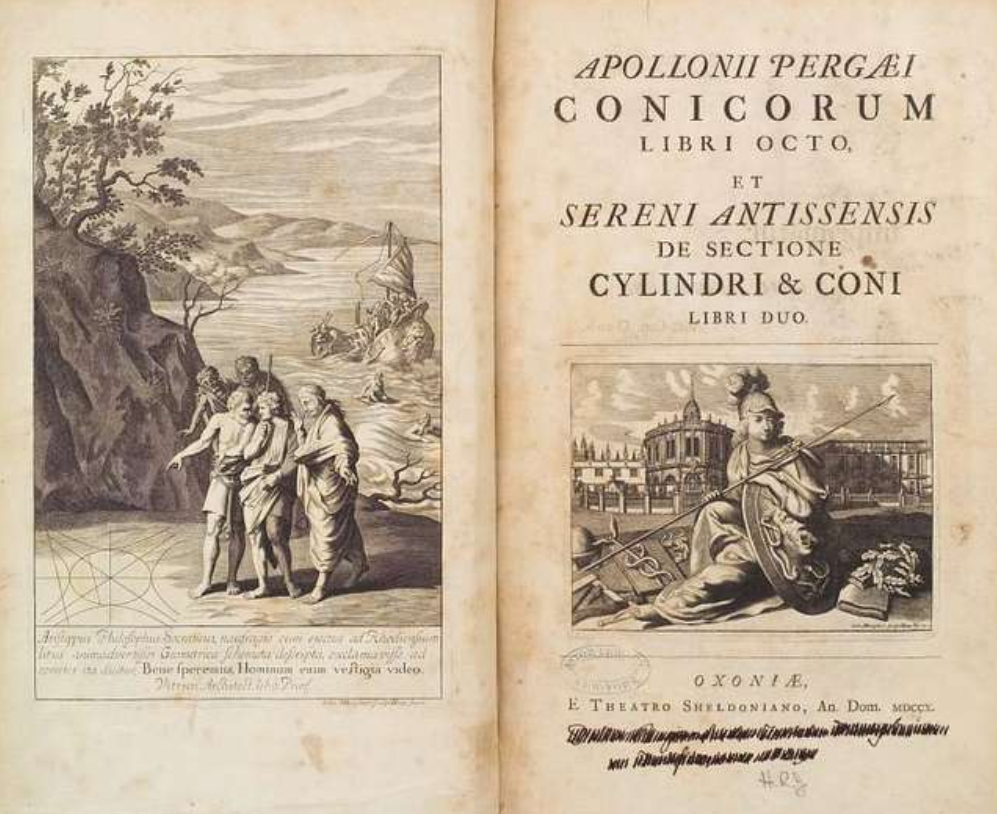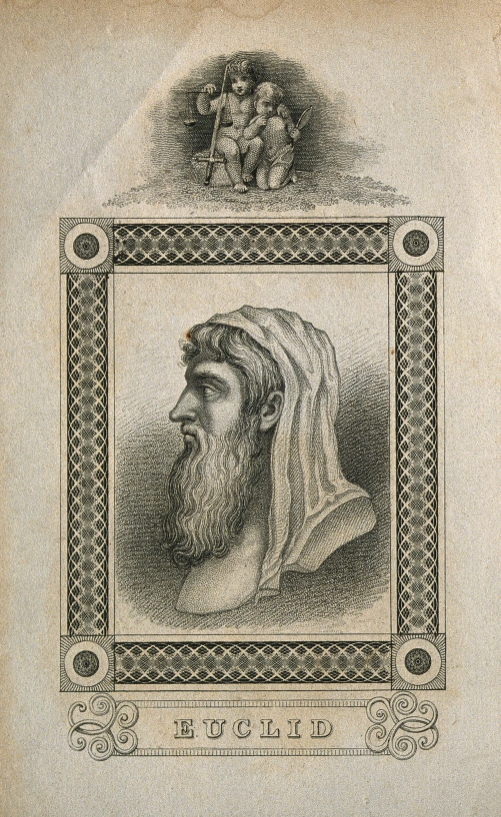Sand Under the Glass
Eighteenth century frontispiece of Apollonii Pergaei Conicorum.
Sand is not a common symbol in ancient thought, compared to more obvious mythological and symbolic substances such as wine or blood or tears or fire, but it is strongly associated with Khronos, in whose emblematic glass sand is time, passing continuously away into oblivion. The number of these grains cannot be reckoned.
The first and second books of Apollonius’s treatise on conic sections, one of the first great works of post-Euclidean mathematics, are dedicated to his friend and colleague Eudemus, and prefaced by letters to the geometer, who lived in Pergamum. In each letter Apollonius asks pointedly after his friend’s health. The third book is undedicated. The fourth is dedicated to another, an Attalus, about whom nothing else is known.
Apollonius and Eudemus likely had met at the academy in Pergamum, where, in the epoch before whiteboards and overhead projectors, they would have studied mathematics together in much the same way as had Euclid and Pythagoras before them—by drawing diagrams in the sand with staves. Papyrus was not inexpensive and the wax tablets used for everyday transactions were small, so a class would gather on the beach to view their instructor creating large, detailed geometric diagrams on the palimpsest earth itself.
The coastline of the Aegean has changed its shape over the centuries. The beach at Miletus where Thales sketched his triangles is gone today; the ruins are now landlocked by about eight kilometers. Aristotle describes the contemplation of geometry as a temporal quest for eternal truths—though according to Parmenides and his followers the Eleatics, such truths are rare and not directly experienced by mortal creatures: only that which is unchanging is not an illusion, and the world that we inhabit is a false world of ephemeral appearances. The sand is washed clean by the tide; the tide itself may recede someday and not return.
The eternal truths are infinite—mathematics is cited by the Pythagoreans as a way to capture the unbounded universe within human understanding (boundlessness, or apeiron, is the same word used by Homer to describe the sea and by Anaximander, a pupil of Thales, to describe the arche, the fundamental principle of the cosmos). With the basic logical axioms of generalization and induction, Apollonius uncovered in the beach, stretching to the horizon, the natures of infinity, and held it within his head, as eternity came to hold him within it. His understanding of hyperbolic curves and asymptotes in the fifth book of Conics prefigured a paradigm shift in the concept of number, and lay the groundwork for calculus. This is also the first of the books whose original texts does not survive, and which is known only in a ninth-century Arabic translation by Thabit ibn Qurra.
The first treatise of Archimedes is called the Sand-Reckoner (Psammites). As a way to develop a system of notation for large numbers and to discuss cosmic dimensions, the geometer sets out to estimate the total number of grains of sand that could exist in the universe. The focus on this question is not arbitrary, but carried the association of impossible or even divine knowledge: Herodotus in the Histories records that the Pythian Oracle at Delphi boasted to Croesus, who dared to doubt her, “I know the number of the grains of sand and the measure of the sea; I understand the speech of the dumb and hear the voiceless.
The philosopher Eubulides of Miletus also used the example of grains of sand to demonstrate the impossibility of certain knowledge. He composed what is now known as the Heap Paradox (Sorites). The paradox calls into question the existence of natural boundaries with the example of the indistinguishability of large quantities.
Ten thousand grains of sand (the paradox goes) is certainly a heap. A heap of sand may be relieved of a single grain and still constitute a heap of sand. Yet one grain of sand certainly is not a heap. There is an unbroken chain of syllogisms all the way down the line, yet somewhere, at some ill-determined point, the same axioms cease to deliver truth. The clean lines of formal logic fail to account for the nebulousness of the world, the definitions that are not defined, the borders that are writ as in sand.
Besides Euclid, one of the greatest influences to Apollonius is Conon of Samos, a friend of Archimedes to whom some of the Syracusan’s own books are dedicated, and who Catullus writes “disclosed the risings and setting of the stars.” The works of Conon are enumerated among those lost in the burning of the Library of Alexandria. None survives. It cannot be numbered, how many secrets have been buried beneath the sands.
The protracted ailment that carried off Eudemus has been lost to the sands of time, but the death of Archimedes has been mythologized, immortalized, whether or not it is actually true (when one tells a story to another who tells it to another who tells it to another, when does it cease to constitute truth?): during the Roman sack of Syracuse, Archimedes was slain by a Roman soldier who discovered him still working out a geometrical problem in the sand. Instead of identifying himself or surrendering or pleading for his life, the geometer cried simply, Me mou tous kuklous taratte!—“Do not disturb my circles!”
Plutarch does not relate whether the soldier actually erased the workings or not after murdering the mathematician, but, if you like, you can go to Syracuse today and check.
Eighteenth century engraving of the face of Euclid.



